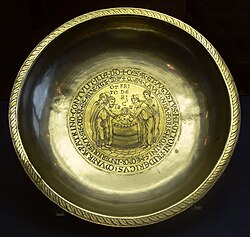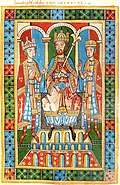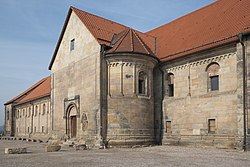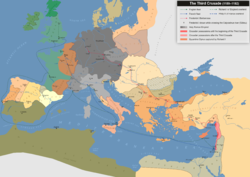Frederick I, Holy Roman Emperor

Frederick Barbarossa (December 1122 — 10 June 1190) was born in 1122 in the monastery Weingarten. He was the son of Frederick II, Duke of Swabia and Guelph Judith. Frederick had a cousin, called "Henry the Lion", who was his greatest enemy. In the year 1152, Frederick Barbarossa was crowned King of Germany.
Nickname
He was named Barbarossa by the northern Italian cities which he attempted to rule: Barbarossa means "red beard" in Italian[1] and German.
Today people know Frederick Barbarossa as a powerful soldier, who tried to conquer Jerusalem and return it to the Christians. He was born in 1122 in a monastery in Altdorf, which is now called Weingarten. During the Middle Ages, most women returned to their birth country, so it is very likely that Frederick’s mother had been born in Altdorf, too.
Frederick's nickname was Barbarossa (“Redbeard”). This was because of his remarkable beard, which was red. “Barba” is the Latin word for beard. “Rossa” is also Latin and means “red”.
Frederick was raised formally and strictly. On 4 March 1142, at the age of 20, Frederick was crowned King of Germany. His cousin, Henry the Lion, was Frederick’s enemy for many years. Henry wanted to become King of Germany, too and therefore was angry when he found out that Barbarossa was to be king and also Emperor of the Holy Roman Empire.
In 1156, he married Lady Beatrix. They had many children. Frederick participated in the third crusade. He never actually reached Jerusalem. It is said that he drowned in the River Saleph in 1190. His soldiers carried his dead body to Jerusalem and buried him there.
Frederick I, Holy Roman Emperor Media
13th-century stained glass image of Frederick I, Strasbourg Cathedral
Pavia, Basilica of San Michele Maggiore, the five stones above which the throne was placed during coronation of Frederick I.
The Barbarossa Chandelier in Aachen Cathedral was donated by Frederick sometime after 1165 as a tribute to Charlemagne.
Frederick Barbarossa, middle, flanked by two of his children, King Henry VI (left) and Duke Frederick VI (right). From the Historia Welforum
The now secularised St Peter's Church at Petersberg Citadel, Erfurt, where Henry the Lion submitted to Barbarossa in 1181
References
- ↑ Iba & Johnson (2015), p. 29








